The Connection Between Sexual Orientation, BMI, and Health Outcomes
VerifiedAdded on 2022/12/27
|7
|1737
|27
Literature Review
AI Summary
This literature review examines the relationship between sexual orientation and Body Mass Index (BMI), focusing on studies that explore weight differences among lesbian, bisexual, and heterosexual women, and the influence of sexual orientation on BMI in both male and female populations. The review synthesizes findings from various studies, including research on Chicago youth, highlighting that sexual minority women often have a higher BMI compared to their heterosexual counterparts, with variations appearing during adolescence and remaining relatively consistent across the lifespan. The analysis considers the potential health risks associated with weight gain and the existing research gaps, emphasizing the need for further studies to understand the underlying factors contributing to these disparities and to inform interventions aimed at improving health outcomes for sexual minorities. It also considers the findings of lower BMI in some studies among gay males compared to heterosexual males. The review also discusses the limitations of current research, including the need for more theoretical frameworks to guide hypothesis generation and testing.
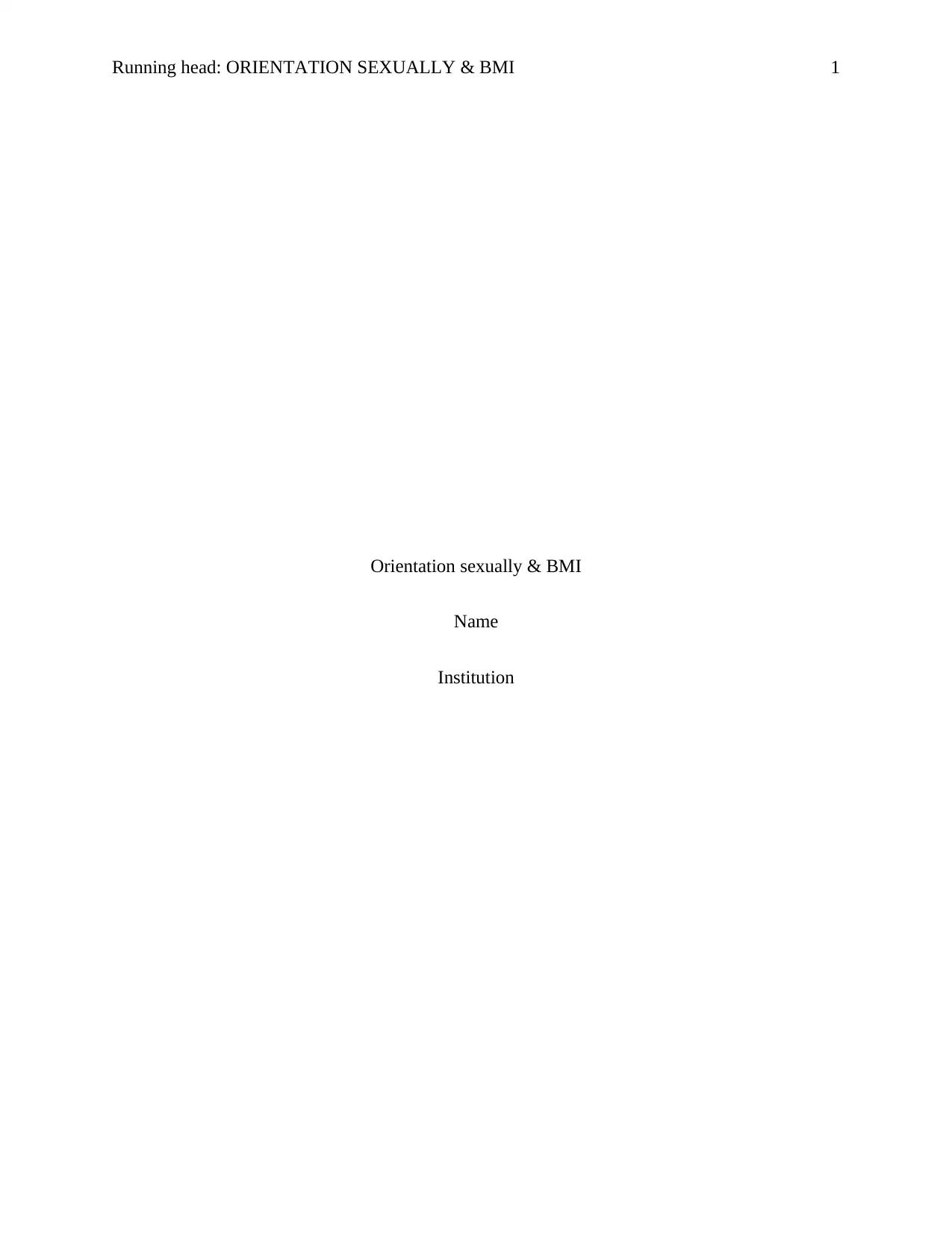
Running head: ORIENTATION SEXUALLY & BMI 1
Orientation sexually & BMI
Name
Institution
Orientation sexually & BMI
Name
Institution
Paraphrase This Document
Need a fresh take? Get an instant paraphrase of this document with our AI Paraphraser
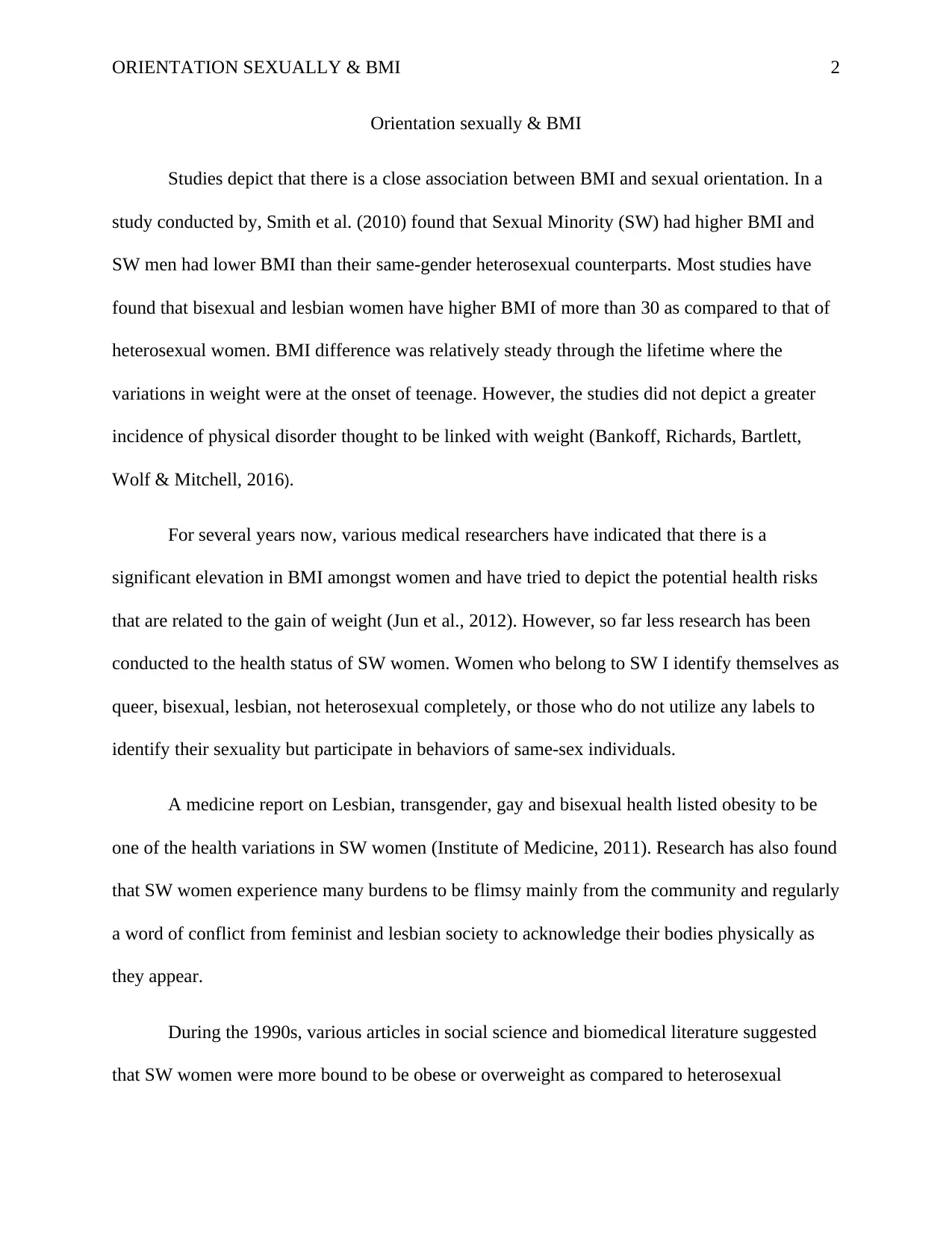
ORIENTATION SEXUALLY & BMI 2
Orientation sexually & BMI
Studies depict that there is a close association between BMI and sexual orientation. In a
study conducted by, Smith et al. (2010) found that Sexual Minority (SW) had higher BMI and
SW men had lower BMI than their same-gender heterosexual counterparts. Most studies have
found that bisexual and lesbian women have higher BMI of more than 30 as compared to that of
heterosexual women. BMI difference was relatively steady through the lifetime where the
variations in weight were at the onset of teenage. However, the studies did not depict a greater
incidence of physical disorder thought to be linked with weight (Bankoff, Richards, Bartlett,
Wolf & Mitchell, 2016).
For several years now, various medical researchers have indicated that there is a
significant elevation in BMI amongst women and have tried to depict the potential health risks
that are related to the gain of weight (Jun et al., 2012). However, so far less research has been
conducted to the health status of SW women. Women who belong to SW I identify themselves as
queer, bisexual, lesbian, not heterosexual completely, or those who do not utilize any labels to
identify their sexuality but participate in behaviors of same-sex individuals.
A medicine report on Lesbian, transgender, gay and bisexual health listed obesity to be
one of the health variations in SW women (Institute of Medicine, 2011). Research has also found
that SW women experience many burdens to be flimsy mainly from the community and regularly
a word of conflict from feminist and lesbian society to acknowledge their bodies physically as
they appear.
During the 1990s, various articles in social science and biomedical literature suggested
that SW women were more bound to be obese or overweight as compared to heterosexual
Orientation sexually & BMI
Studies depict that there is a close association between BMI and sexual orientation. In a
study conducted by, Smith et al. (2010) found that Sexual Minority (SW) had higher BMI and
SW men had lower BMI than their same-gender heterosexual counterparts. Most studies have
found that bisexual and lesbian women have higher BMI of more than 30 as compared to that of
heterosexual women. BMI difference was relatively steady through the lifetime where the
variations in weight were at the onset of teenage. However, the studies did not depict a greater
incidence of physical disorder thought to be linked with weight (Bankoff, Richards, Bartlett,
Wolf & Mitchell, 2016).
For several years now, various medical researchers have indicated that there is a
significant elevation in BMI amongst women and have tried to depict the potential health risks
that are related to the gain of weight (Jun et al., 2012). However, so far less research has been
conducted to the health status of SW women. Women who belong to SW I identify themselves as
queer, bisexual, lesbian, not heterosexual completely, or those who do not utilize any labels to
identify their sexuality but participate in behaviors of same-sex individuals.
A medicine report on Lesbian, transgender, gay and bisexual health listed obesity to be
one of the health variations in SW women (Institute of Medicine, 2011). Research has also found
that SW women experience many burdens to be flimsy mainly from the community and regularly
a word of conflict from feminist and lesbian society to acknowledge their bodies physically as
they appear.
During the 1990s, various articles in social science and biomedical literature suggested
that SW women were more bound to be obese or overweight as compared to heterosexual
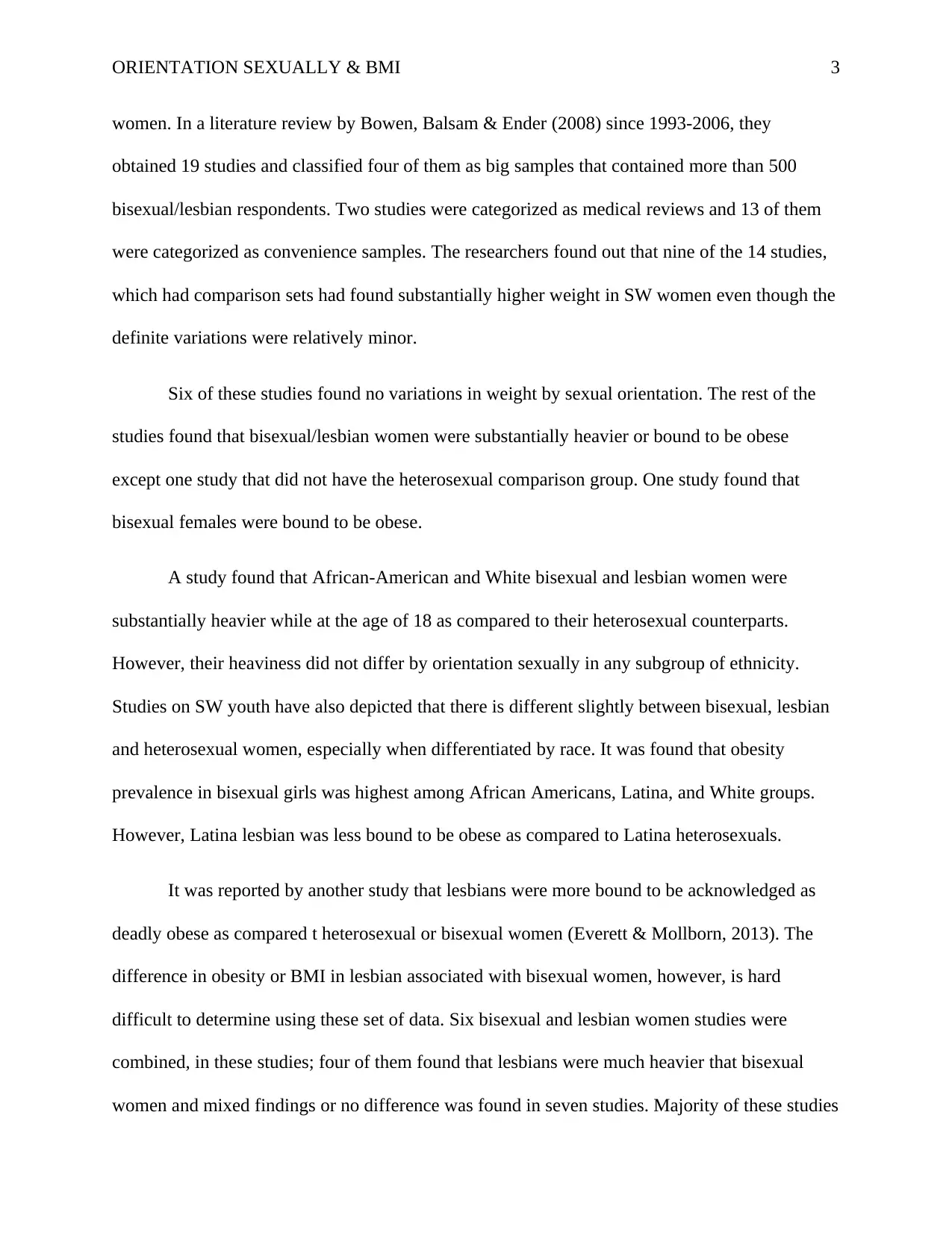
ORIENTATION SEXUALLY & BMI 3
women. In a literature review by Bowen, Balsam & Ender (2008) since 1993-2006, they
obtained 19 studies and classified four of them as big samples that contained more than 500
bisexual/lesbian respondents. Two studies were categorized as medical reviews and 13 of them
were categorized as convenience samples. The researchers found out that nine of the 14 studies,
which had comparison sets had found substantially higher weight in SW women even though the
definite variations were relatively minor.
Six of these studies found no variations in weight by sexual orientation. The rest of the
studies found that bisexual/lesbian women were substantially heavier or bound to be obese
except one study that did not have the heterosexual comparison group. One study found that
bisexual females were bound to be obese.
A study found that African-American and White bisexual and lesbian women were
substantially heavier while at the age of 18 as compared to their heterosexual counterparts.
However, their heaviness did not differ by orientation sexually in any subgroup of ethnicity.
Studies on SW youth have also depicted that there is different slightly between bisexual, lesbian
and heterosexual women, especially when differentiated by race. It was found that obesity
prevalence in bisexual girls was highest among African Americans, Latina, and White groups.
However, Latina lesbian was less bound to be obese as compared to Latina heterosexuals.
It was reported by another study that lesbians were more bound to be acknowledged as
deadly obese as compared t heterosexual or bisexual women (Everett & Mollborn, 2013). The
difference in obesity or BMI in lesbian associated with bisexual women, however, is hard
difficult to determine using these set of data. Six bisexual and lesbian women studies were
combined, in these studies; four of them found that lesbians were much heavier that bisexual
women and mixed findings or no difference was found in seven studies. Majority of these studies
women. In a literature review by Bowen, Balsam & Ender (2008) since 1993-2006, they
obtained 19 studies and classified four of them as big samples that contained more than 500
bisexual/lesbian respondents. Two studies were categorized as medical reviews and 13 of them
were categorized as convenience samples. The researchers found out that nine of the 14 studies,
which had comparison sets had found substantially higher weight in SW women even though the
definite variations were relatively minor.
Six of these studies found no variations in weight by sexual orientation. The rest of the
studies found that bisexual/lesbian women were substantially heavier or bound to be obese
except one study that did not have the heterosexual comparison group. One study found that
bisexual females were bound to be obese.
A study found that African-American and White bisexual and lesbian women were
substantially heavier while at the age of 18 as compared to their heterosexual counterparts.
However, their heaviness did not differ by orientation sexually in any subgroup of ethnicity.
Studies on SW youth have also depicted that there is different slightly between bisexual, lesbian
and heterosexual women, especially when differentiated by race. It was found that obesity
prevalence in bisexual girls was highest among African Americans, Latina, and White groups.
However, Latina lesbian was less bound to be obese as compared to Latina heterosexuals.
It was reported by another study that lesbians were more bound to be acknowledged as
deadly obese as compared t heterosexual or bisexual women (Everett & Mollborn, 2013). The
difference in obesity or BMI in lesbian associated with bisexual women, however, is hard
difficult to determine using these set of data. Six bisexual and lesbian women studies were
combined, in these studies; four of them found that lesbians were much heavier that bisexual
women and mixed findings or no difference was found in seven studies. Majority of these studies
⊘ This is a preview!⊘
Do you want full access?
Subscribe today to unlock all pages.

Trusted by 1+ million students worldwide
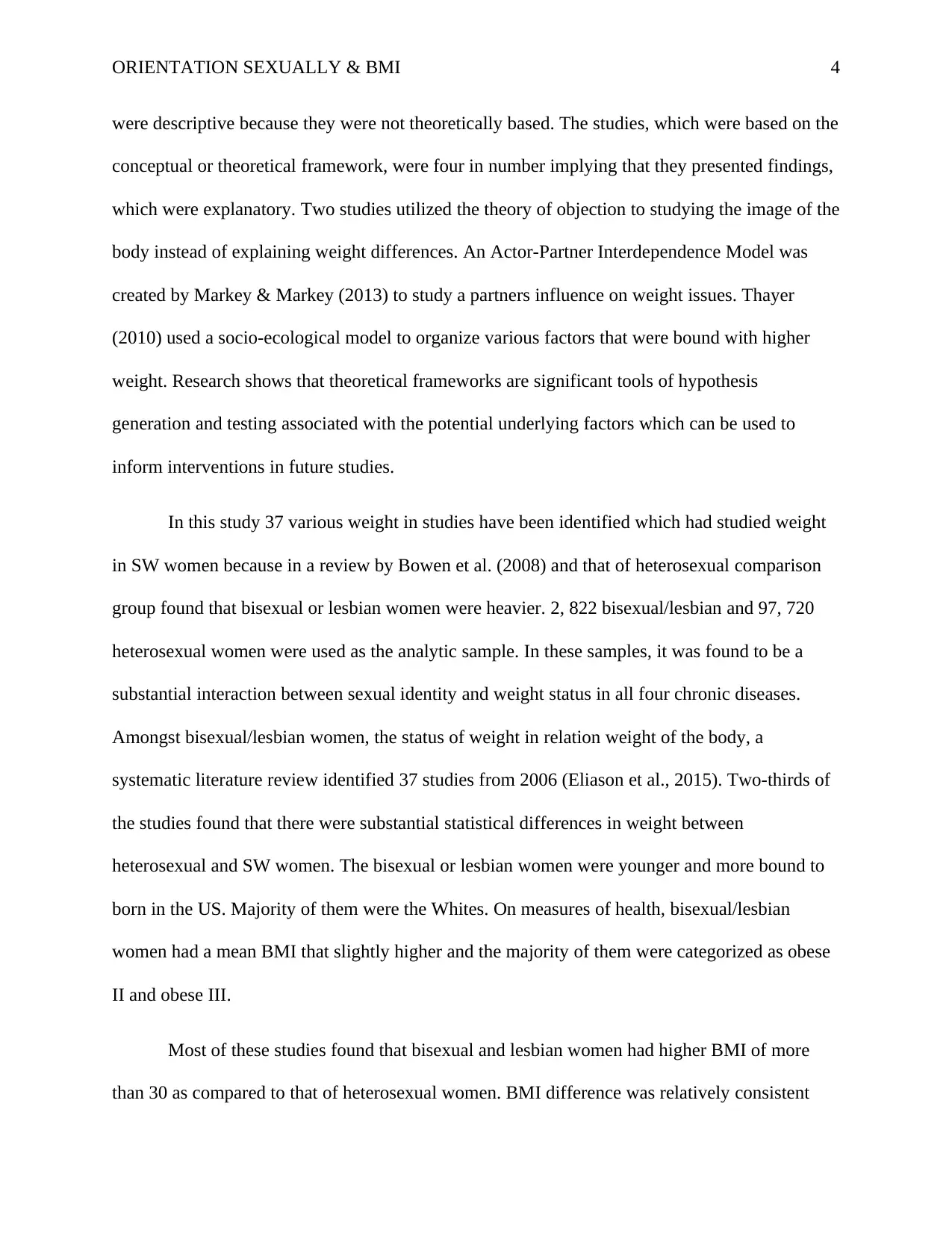
ORIENTATION SEXUALLY & BMI 4
were descriptive because they were not theoretically based. The studies, which were based on the
conceptual or theoretical framework, were four in number implying that they presented findings,
which were explanatory. Two studies utilized the theory of objection to studying the image of the
body instead of explaining weight differences. An Actor-Partner Interdependence Model was
created by Markey & Markey (2013) to study a partners influence on weight issues. Thayer
(2010) used a socio-ecological model to organize various factors that were bound with higher
weight. Research shows that theoretical frameworks are significant tools of hypothesis
generation and testing associated with the potential underlying factors which can be used to
inform interventions in future studies.
In this study 37 various weight in studies have been identified which had studied weight
in SW women because in a review by Bowen et al. (2008) and that of heterosexual comparison
group found that bisexual or lesbian women were heavier. 2, 822 bisexual/lesbian and 97, 720
heterosexual women were used as the analytic sample. In these samples, it was found to be a
substantial interaction between sexual identity and weight status in all four chronic diseases.
Amongst bisexual/lesbian women, the status of weight in relation weight of the body, a
systematic literature review identified 37 studies from 2006 (Eliason et al., 2015). Two-thirds of
the studies found that there were substantial statistical differences in weight between
heterosexual and SW women. The bisexual or lesbian women were younger and more bound to
born in the US. Majority of them were the Whites. On measures of health, bisexual/lesbian
women had a mean BMI that slightly higher and the majority of them were categorized as obese
II and obese III.
Most of these studies found that bisexual and lesbian women had higher BMI of more
than 30 as compared to that of heterosexual women. BMI difference was relatively consistent
were descriptive because they were not theoretically based. The studies, which were based on the
conceptual or theoretical framework, were four in number implying that they presented findings,
which were explanatory. Two studies utilized the theory of objection to studying the image of the
body instead of explaining weight differences. An Actor-Partner Interdependence Model was
created by Markey & Markey (2013) to study a partners influence on weight issues. Thayer
(2010) used a socio-ecological model to organize various factors that were bound with higher
weight. Research shows that theoretical frameworks are significant tools of hypothesis
generation and testing associated with the potential underlying factors which can be used to
inform interventions in future studies.
In this study 37 various weight in studies have been identified which had studied weight
in SW women because in a review by Bowen et al. (2008) and that of heterosexual comparison
group found that bisexual or lesbian women were heavier. 2, 822 bisexual/lesbian and 97, 720
heterosexual women were used as the analytic sample. In these samples, it was found to be a
substantial interaction between sexual identity and weight status in all four chronic diseases.
Amongst bisexual/lesbian women, the status of weight in relation weight of the body, a
systematic literature review identified 37 studies from 2006 (Eliason et al., 2015). Two-thirds of
the studies found that there were substantial statistical differences in weight between
heterosexual and SW women. The bisexual or lesbian women were younger and more bound to
born in the US. Majority of them were the Whites. On measures of health, bisexual/lesbian
women had a mean BMI that slightly higher and the majority of them were categorized as obese
II and obese III.
Most of these studies found that bisexual and lesbian women had higher BMI of more
than 30 as compared to that of heterosexual women. BMI difference was relatively consistent
Paraphrase This Document
Need a fresh take? Get an instant paraphrase of this document with our AI Paraphraser
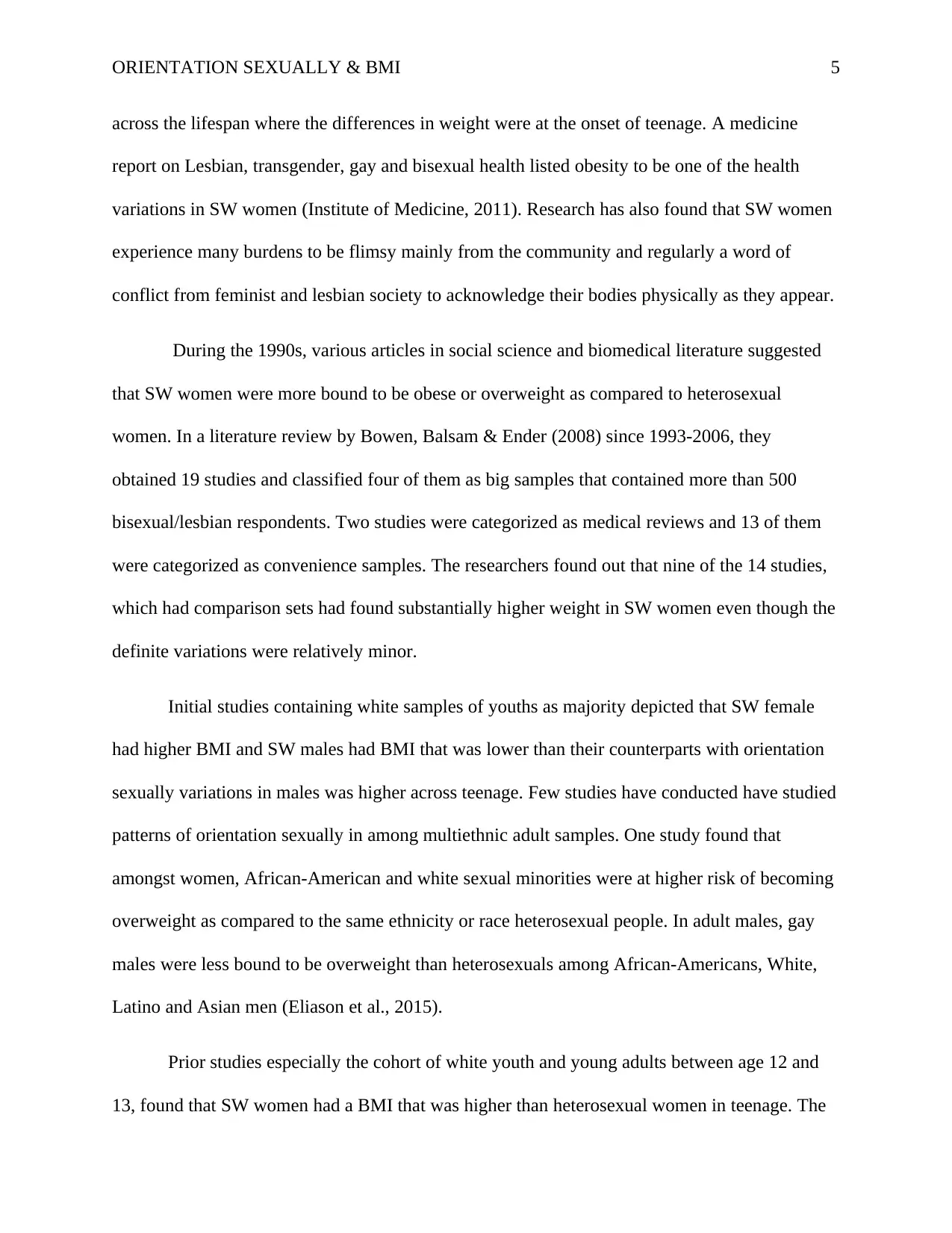
ORIENTATION SEXUALLY & BMI 5
across the lifespan where the differences in weight were at the onset of teenage. A medicine
report on Lesbian, transgender, gay and bisexual health listed obesity to be one of the health
variations in SW women (Institute of Medicine, 2011). Research has also found that SW women
experience many burdens to be flimsy mainly from the community and regularly a word of
conflict from feminist and lesbian society to acknowledge their bodies physically as they appear.
During the 1990s, various articles in social science and biomedical literature suggested
that SW women were more bound to be obese or overweight as compared to heterosexual
women. In a literature review by Bowen, Balsam & Ender (2008) since 1993-2006, they
obtained 19 studies and classified four of them as big samples that contained more than 500
bisexual/lesbian respondents. Two studies were categorized as medical reviews and 13 of them
were categorized as convenience samples. The researchers found out that nine of the 14 studies,
which had comparison sets had found substantially higher weight in SW women even though the
definite variations were relatively minor.
Initial studies containing white samples of youths as majority depicted that SW female
had higher BMI and SW males had BMI that was lower than their counterparts with orientation
sexually variations in males was higher across teenage. Few studies have conducted have studied
patterns of orientation sexually in among multiethnic adult samples. One study found that
amongst women, African-American and white sexual minorities were at higher risk of becoming
overweight as compared to the same ethnicity or race heterosexual people. In adult males, gay
males were less bound to be overweight than heterosexuals among African-Americans, White,
Latino and Asian men (Eliason et al., 2015).
Prior studies especially the cohort of white youth and young adults between age 12 and
13, found that SW women had a BMI that was higher than heterosexual women in teenage. The
across the lifespan where the differences in weight were at the onset of teenage. A medicine
report on Lesbian, transgender, gay and bisexual health listed obesity to be one of the health
variations in SW women (Institute of Medicine, 2011). Research has also found that SW women
experience many burdens to be flimsy mainly from the community and regularly a word of
conflict from feminist and lesbian society to acknowledge their bodies physically as they appear.
During the 1990s, various articles in social science and biomedical literature suggested
that SW women were more bound to be obese or overweight as compared to heterosexual
women. In a literature review by Bowen, Balsam & Ender (2008) since 1993-2006, they
obtained 19 studies and classified four of them as big samples that contained more than 500
bisexual/lesbian respondents. Two studies were categorized as medical reviews and 13 of them
were categorized as convenience samples. The researchers found out that nine of the 14 studies,
which had comparison sets had found substantially higher weight in SW women even though the
definite variations were relatively minor.
Initial studies containing white samples of youths as majority depicted that SW female
had higher BMI and SW males had BMI that was lower than their counterparts with orientation
sexually variations in males was higher across teenage. Few studies have conducted have studied
patterns of orientation sexually in among multiethnic adult samples. One study found that
amongst women, African-American and white sexual minorities were at higher risk of becoming
overweight as compared to the same ethnicity or race heterosexual people. In adult males, gay
males were less bound to be overweight than heterosexuals among African-Americans, White,
Latino and Asian men (Eliason et al., 2015).
Prior studies especially the cohort of white youth and young adults between age 12 and
13, found that SW women had a BMI that was higher than heterosexual women in teenage. The

ORIENTATION SEXUALLY & BMI 6
same pattern was observed in adult women. In the same cohort, it was found that gay males had
BMI, which was higher in early teenage as compared to heterosexual males, however; in late
teenage, gay males had lower BMI than their peer heterosexuals. The same pattern was observed
in adult males (Eliason, Sanchez-Vaznaugh & Stupplebeen, 2017).
same pattern was observed in adult women. In the same cohort, it was found that gay males had
BMI, which was higher in early teenage as compared to heterosexual males, however; in late
teenage, gay males had lower BMI than their peer heterosexuals. The same pattern was observed
in adult males (Eliason, Sanchez-Vaznaugh & Stupplebeen, 2017).
⊘ This is a preview!⊘
Do you want full access?
Subscribe today to unlock all pages.

Trusted by 1+ million students worldwide

ORIENTATION SEXUALLY & BMI 7
References
Bankoff, S., Richards, L., Bartlett, B., Wolf, E., & Mitchell, K. (2016). Examining weight and
eating behavior by orientation sexually in a sample of male veterans. Comprehensive
Psychiatry, 68, 134-139.
Eliason, M., Ingraham, N., Fogel, S., McElroy, J., Lorvick, J., Mauery, D., & Haynes, S. (2015).
A Systematic Review of the Literature on Weight in SW Women. Women's Health
Issues, 25(2), 162-175.
Eliason, M., Sanchez-Vaznaugh, E., & Stupplebeen, D. (2017). Relationships between
Orientation sexually, Weight, and Health in a Population-Based Sample of California
Women. Women's Health Issues, 27(5), 600-606.
Katz-Wise, S., Blood, E., Milliren, C., Calzo, J., Richmond, T., Gooding, H., & Austin, S.
(2014). Orientation sexually Disparities in BMI among US Adolescents and Young Adults
in Three Race/Ethnicity Groups. Journal of Obesity, 2014, 1-8.
Smith, H., Markovic, N., Danielson, M., Matthews, A., Youk, A., & Talbott, E. et al. (2010).
Sexual Abuse, Orientation sexually, and Obesity in Women. Journal of Women's
Health, 19(8), 1525-1532.
References
Bankoff, S., Richards, L., Bartlett, B., Wolf, E., & Mitchell, K. (2016). Examining weight and
eating behavior by orientation sexually in a sample of male veterans. Comprehensive
Psychiatry, 68, 134-139.
Eliason, M., Ingraham, N., Fogel, S., McElroy, J., Lorvick, J., Mauery, D., & Haynes, S. (2015).
A Systematic Review of the Literature on Weight in SW Women. Women's Health
Issues, 25(2), 162-175.
Eliason, M., Sanchez-Vaznaugh, E., & Stupplebeen, D. (2017). Relationships between
Orientation sexually, Weight, and Health in a Population-Based Sample of California
Women. Women's Health Issues, 27(5), 600-606.
Katz-Wise, S., Blood, E., Milliren, C., Calzo, J., Richmond, T., Gooding, H., & Austin, S.
(2014). Orientation sexually Disparities in BMI among US Adolescents and Young Adults
in Three Race/Ethnicity Groups. Journal of Obesity, 2014, 1-8.
Smith, H., Markovic, N., Danielson, M., Matthews, A., Youk, A., & Talbott, E. et al. (2010).
Sexual Abuse, Orientation sexually, and Obesity in Women. Journal of Women's
Health, 19(8), 1525-1532.
1 out of 7
Your All-in-One AI-Powered Toolkit for Academic Success.
+13062052269
info@desklib.com
Available 24*7 on WhatsApp / Email
![[object Object]](/_next/static/media/star-bottom.7253800d.svg)
Unlock your academic potential
Copyright © 2020–2025 A2Z Services. All Rights Reserved. Developed and managed by ZUCOL.


